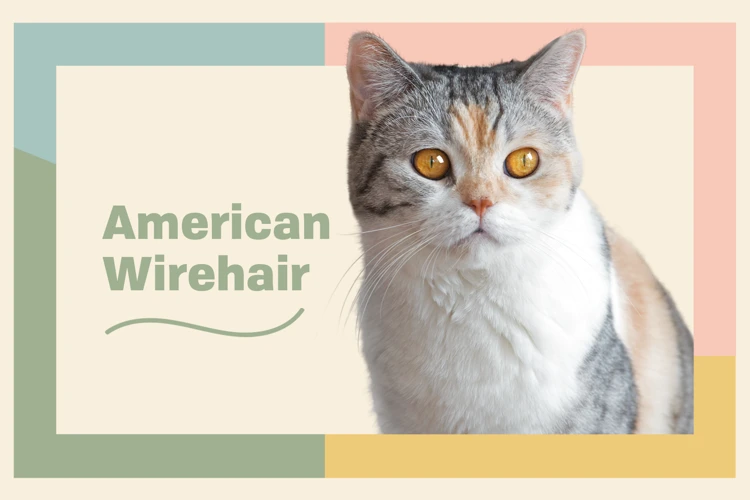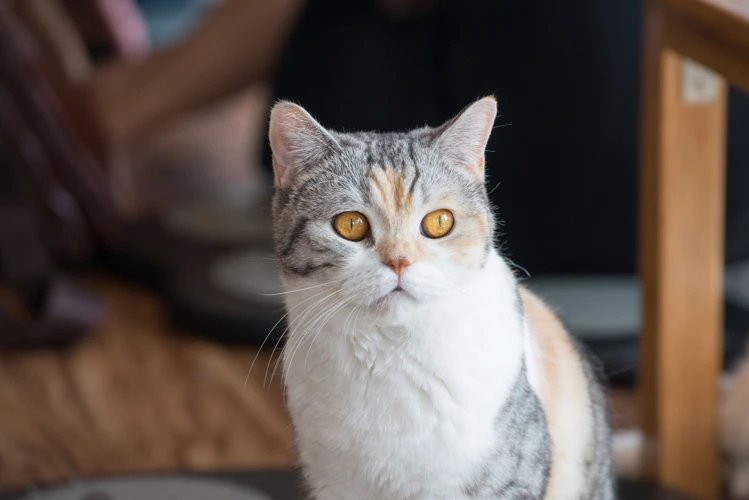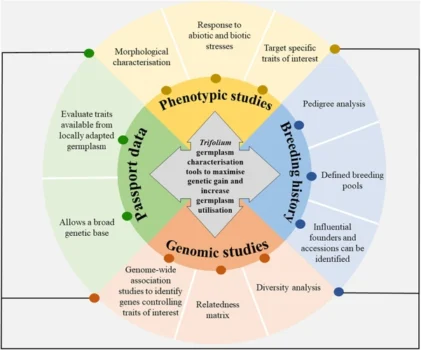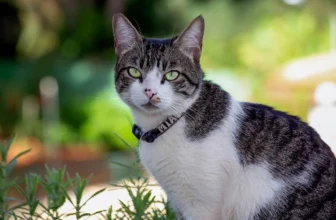As an American Wirehair cat owner, you want to ensure that your furry friend is healthy, happy, and well taken care of. If you are considering breeding your cat, you want to ensure that you find the best possible mate for them. One important factor to consider when choosing a breeding partner is their pedigree history. Pedigree analysis allows you to evaluate a potential mate’s breeding history, health traits, and compatibility with your American Wirehair. In this article, we will explore the role of pedigree analysis in selecting a breeding partner for your American Wirehair in detail. From understanding pedigree analysis to using it to select the right mate, we’ve got you covered.
Understanding Pedigree Analysis

As a passionate American Wirehair breeder, selecting the right breeding partner plays a crucial role in the future success of your breeding program. One of the essential tools in evaluating a potential breeding partner is pedigree analysis. Pedigree analysis provides valuable insights into a cat’s genetic makeup, which can assist in determining if a particular cat fits the desired breeding goals. In this section, we will explore the benefits and limitations of pedigree analysis, as well as its role in the breeding process. It’s important to note that pedigree analysis should be used in conjunction with other factors, such as health and temperament when making breeding decisions. For more information on these factors, visit our article “American Wirehair Breeding: Health and Temperament.”
What is Pedigree Analysis?
Pedigree analysis is a crucial tool for any breeder when it comes to selecting a suitable breeding partner for their American Wirehair. It involves examining the family tree or pedigree of the cat in order to determine its genetic makeup and the likelihood of passing on certain traits to its offspring. By doing so, breeders can make informed decisions when it comes to selecting a breeding partner that will produce healthy and desirable kittens.
Some of the information that can be obtained through pedigree analysis includes:
| Information Obtained Through Pedigree Analysis | Explanation |
|---|---|
| Genetic Disorders | Through pedigree analysis, breeders can determine if a particular cat has a history of genetic diseases or disorders. This can help to reduce the risk of these conditions being passed on to the next generation. |
| Breeding Traits | By examining the pedigree of a cat, breeders can identify certain characteristics that are common within the breed. This can help to ensure that the kittens produced will have desirable traits such as a wirehair coat. |
| Inbreeding | Pedigree analysis can identify if a particular cat has a history of inbreeding which can lead to health problems in the offspring. It can also be used to calculate the inbreeding coefficient of potential breeding pairs to ensure that the risk of genetic defects is minimized. |
| Outbreeding | Just as inbreeding, outbreeding may have it’s advantages and disadvantages. By analyzing the pedigree, breeders can determine whether outbreeding is a suitable option for breeding with a particular cat. |
Pedigree analysis is an important aspect of American Wirehair breeding, as it allows breeders to make more informed decisions about which cats they will breed together. By considering the history and genetic makeup of potential breeding partners, breeders can work towards producing healthy and desirable kittens that meet the breed standard.
If you are interested in learning more about the wirehair breeding traits, the importance of genetic testing, common mistakes in breeding, choosing the right breeding partner, and other topics related to American Wirehair breeding, be sure to check out our other articles:
Wirehair Breeding Traits,
Importance of Genetic Testing in Breeding American Wirehair,
Choosing a Compatible Breeding Partner for Your American Wirehair,
Pros and Cons of Inbreeding and Outbreeding in American Wirehair Breeding,
Coat Color and Pattern in American Wirehair Breeding,
Benefits of Crossbreeding American Wirehair Cats.
Benefits of Pedigree Analysis
Pedigree analysis is a valuable tool in selecting a breeding partner for your American Wirehair. Here are some of the benefits of pedigree analysis:
- Identification of Genetic Disorders: Pedigree analysis can help identify genetic disorders that may be present in particular bloodlines. This information can be used to avoid breeding individuals who may carry the gene for a particular disorder, thus reducing the risk of passing on these health problems to future litters.
- Assessment of Genetic Diversity: Pedigree analysis can evaluate the level of inbreeding within a bloodline, which can help breeders make informed decisions about future breeding matches. A high level of inbreeding can increase the risk of genetic disorders and decrease genetic diversity, which is important for maintaining the overall health and vigor of the breed.
- Tracking Lineage: Pedigree analysis helps track the lineage of a particular individual, which can help breeders identify desirable traits that are consistently passed down from generation to generation.
- Improvement of Breed: Pedigree analysis can help breeders make strategic breeding decisions aimed at improving the breed as a whole. By selecting breeding partners with desirable traits and bloodlines, breeders can move the breed forward and reduce the prevalence of undesirable traits.
Pedigree analysis can provide valuable insights into the history and potential future of a bloodline. While it is not the only factor to consider in selecting a breeding partner, it is an important tool that can help breeders make informed decisions. However, it is essential to keep in mind the limitations of pedigree analysis, and to consider other factors such as health, temperament, and compatibility when making breeding decisions. To learn more about common mistakes in American Wirehair breeding, visit our article on common breeding mistakes to avoid.
Limitations of Pedigree Analysis
It is essential to understand that while pedigree analysis is a valuable tool for selecting a breeding partner for your American Wirehair, it has its limitations. Here are some of the limitations that you should keep in mind:
- Limitations of Genetic Information: Pedigree analysis can provide information about the genetic makeup of the breeding partner and their ancestors. However, genetic information alone is not enough to ensure the quality of their offspring. Many genetic traits are influenced by environmental factors or by the interaction of several genes, making them difficult to predict.
- Limitations of Pedigree Records: Pedigree records may not always provide complete information about a breeding partner, their ancestors, or their pedigree history. Some records may have errors or omissions, while others may not exist at all.
- Limitations of Inbreeding: Inbreeding can increase the chances of genetic disorders and decrease the genetic diversity of the offspring. While pedigree analysis can identify potential risks of inbreeding, it does not guarantee the avoidance of these risks entirely.
- Limitations of Behavioral Traits: Pedigree analysis may not provide information about the personality and temperament of the breeding partner. These traits are also determined by environmental factors and may not be passed on genetically.
- Limitations of Physical Characteristics: Pedigree analysis can provide information about physical traits that are passed down genetically, but it cannot guarantee that these traits will be present in the offspring. Genetic variations or environmental factors can cause variations in the physical characteristics of the offspring.
- Limitations of Compatibility: Pedigree analysis can identify potential compatibility issues between a breeding partner and your American Wirehair. However, it cannot guarantee the success of the breeding partnership. Other factors such as the breeding conditions, the health and age of the animals, and the skill of the breeder can also impact the success of the breeding partnership.
Keep these limitations in mind when using pedigree analysis to select a breeding partner for your American Wirehair. While pedigree analysis is a useful tool, it should be used in conjunction with other factors such as health, personality, physical characteristics, and compatibility to ensure the quality of the offspring and the success of the breeding partnership.
Evaluating a Breeding Partner

When deciding to breed your American Wirehair, it’s vital to take the time to evaluate potential breeding partners carefully. The process requires a thorough assessment of various traits and characteristics that contribute to a healthy and successful litter. In this section, we explore the key factors to consider when evaluating a breeding partner, from their health and genetic traits to their personality, physical characteristics, pedigree history, previous litters, and compatibility with your American Wirehair. With this information in mind, you’ll be able to make an informed decision about the best breeding partner for your pet.
Health and Genetic Traits
When evaluating a potential breeding partner for your American Wirehair, it is crucial to consider their health and genetic traits. Here are some specific aspects to keep in mind when assessing this:
- Health history: Obtain a complete history of the potential partner’s health, including any illnesses, injuries, or surgeries. Look for indicators of good health, such as a shiny coat, bright eyes, and no signs of sickness.
- Genetic testing: Conducting genetic testing can identify potential health issues and help reduce the risk of inherited diseases. Be sure to ask if the potential partner has undergone any genetic testing and review the results with a veterinarian.
- Known health issues: Research the breed of the potential partner to determine if there are any common health issues to be aware of. If they have a known history of any health problems, it’s important to assess the likelihood of these issues being passed onto offspring.
- Immune system: A healthy immune system is vital for any animal, especially in breeding. Ensure that the potential partner is up-to-date on their vaccinations and has no history of chronic infections.
Consider these factors when evaluating the potential breeding partner’s health and genetic traits. It’s best to consult with a veterinarian to ensure you have all the necessary information to make an informed decision. Remember- the health of your future litter depends on the health of the parents!
Personality and Temperament
When choosing a breeding partner for your American Wirehair, it’s crucial to take into account their personality and temperament. You want to ensure that the breeding partner you select not only has desirable physical traits but also has a personality and temperament that will produce kittens that meet your expectations. Here are some factors to consider when evaluating a breeding partner’s personality and temperament:
| Factor | Description |
|---|---|
| Activity level | Is the breeding partner energetic and playful or more laid back and independent? Consider if their activity level aligns with what you want in a kitten. |
| Socialization | How does the breeding partner interact with humans and other animals? You want to select a partner with a friendly, outgoing nature who isn’t aggressive towards others. |
| Temperament | Is the breeding partner generally calm and easygoing or easily agitated and anxious? Look for a partner with a stable temperament that won’t pass on excessive anxiety or aggression to their offspring. |
| Trainability | Is the breeding partner smart and trainable or stubborn and difficult to work with? Look for a partner with high trainability to produce kittens that are easy to train and responsive to commands. |
| Behavioral Issues | Does the breeding partner exhibit any problematic behaviors such as excessive barking or destructive chewing? Avoid selecting a partner with these issues as they may be passed on to their offspring. |
By taking these factors into account, you can ensure that the breeding partner you select will produce kittens that meet not only your physical expectations but also your behavioral ones. Remember that personality and temperament are just as important as physical traits when it comes to breeding American Wirehairs.
Physical Characteristics
When considering a breeding partner for your American Wirehair, physical characteristics are an important factor to evaluate. These include the cat’s overall body structure, coat color and texture, eye shape and color, and more.
One way to keep track of different physical characteristics is by creating an organized table. Use columns for each characteristic and rows for each breeding partner you’re considering. This makes it easy to compare and contrast the physical traits of each potential partner.
Body Structure
Typically, American Wirehairs have a robust and sturdy body structure. When looking for a breeding partner, you’ll want to ensure their body structure is similarly solid. Take note of the cat’s weight and height, as well as their overall musculature.
Coat Color and Texture
American Wirehairs have a distinctive coat texture that’s wiry and dense. Look for a breeding partner with a similar coat texture, as well as a coat color that complements your American Wirehair. Keep in mind that coat color can be a result of genetics, so assessing a breeding partner’s coat color can give you valuable insight into their genetic makeup.
Eye Shape and Color
Eye shape and color can also be indicative of genetic traits. For American Wirehairs, round eyes that are colored gold, copper, or green are typical. Take note of a breeding partner’s eye shape and color to get a sense of their genetic history.
Facial Features
Facial features can also be a helpful indicator of a breeding partner’s genetic traits. American Wirehairs have a distinctive expression with prominent cheekbones and a wide-set nose. Observe a breeding partner’s facial features to see if they have similar traits.
Other Physical Traits
Other physical traits to take note of include the cat’s ears, tail, and paw pads. For American Wirehairs, the ears should be medium-sized with rounded tips, and their paw pads should be thick and tough. Take note of these features to ensure compatibility with your own American Wirehair.
When evaluating a breeding partner’s physical characteristics, it’s important to keep in mind that no cat is perfect. It’s about finding a partner whose physical traits complement your own American Wirehair’s traits and who has a good genetic history overall. Using a table to organize and compare physical traits can be a helpful tool in making an informed decision.
Pedigree History
When evaluating a breeding partner for your American Wirehair, it’s crucial to examine their pedigree history. A pedigree is a chart that shows the genetic makeup of an animal and its ancestors. By studying a breeding partner’s pedigree, you can get insights into their ancestors’ traits, health, and temperament.
When examining the pedigree history, it’s essential to look for strong and healthy bloodlines. This means that the animal does not come from a line with a history of genetic illnesses or defects. Look for bold and healthy parentage in the pedigree chart, keeping an eye out for any genetic issues that have been documented in previous generations.
One way to examine the pedigree is to create a table that shows the different generations and the animals’ names, traits, and health records. This table should include the animal’s name, gender, color, date of birth, registration number, history of any health problems, and awards or accolades they have received.
By examining this chart, you can get an understanding of how the bloodline has evolved over generations. It will help you to identify any weak areas that need to be strengthened in the breeding partner. You can also determine what traits have been dominant in the line and how they have been passed down.
It is essential to emphasize strong points seen in a breeding partner’s pedigree history. For instance, if their pedigree records show that they have an impressive lineage of show champions, record this information in your table and highlight them in bold or different color. This information can give you confidence that you are selecting a breeding partner that has healthy traits.
The pedigree history of a breeding partner is a crucial aspect to consider when selecting an American Wirehair. By thoroughly analyzing and examining the pedigree charts, you can gain valuable insights into the animal’s health, genetic makeup, and temperament, which will ultimately lead to a successful breeding partnership.
Previous Litters
When considering choosing a breeding partner for your American Wirehair, it’s important to take a close look at their previous litters. This information can give you a good idea of what to expect in terms of the health and temperament of your potential offspring.
Health Records: Start by asking the breeder about the health records of the previous litters, especially if there were any health issues or congenital defects. It’s important to make sure that the breeding partner has been genetically screened for any hereditary diseases or conditions.
Temperament of Offspring: The temperament of the offspring can also provide valuable insight into the breeding partner’s personality. Were the kittens friendly, curious, and playful? Did they display any reactive or aggressive behaviors? Keep in mind that a cat’s personality is influenced by both genetics and environment, so it’s important to assess the personality of the previous litter in conjunction with other factors.
Physical Characteristics: Another important factor to consider when evaluating a breeding partner’s previous litter is their physical characteristics. Did the kittens have the desired coat and eye color? Were they of the correct size and weight for their age? Examining these types of physical traits can help ensure that the breeding partner is a good match for producing healthy and high-quality offspring.
Using an organized table can be helpful for keeping track of this information and comparing different breeding partners:
| Breeding Partner | Health Records | Temperament of Offspring | Physical Characteristics |
|---|---|---|---|
| Partner A | Genetically screened, no health issues | Friendly, playful, curious | Desired coat and eye color, correct size |
| Partner B | Screened, minor health issues | Shy, timid, reactive | Incorrect coat color, underweight |
| Partner C | No health records available | Aggressive, destructive, difficult | Irrelevant characteristics |
Studying the previous litters of a potential breeding partner can be an important step in ensuring that your American Wirehair kittens will have the desirable traits and characteristics that you’re looking for. By taking a thorough approach to evaluating a breeding partner’s previous litters, you can help create the best possible outcome for your future feline family.
Compatibility with Your American Wirehair
When selecting a breeding partner for your American Wirehair, compatibility is an important factor to consider. This involves evaluating whether the potential partner will be a good match for your American Wirehair in terms of temperament, energy level, and behavior.
Temperament: The American Wirehair has a unique personality that should be taken into account when selecting a breeding partner. This breed is typically friendly, affectionate, and playful. It is essential to choose a partner that displays similar traits and temperament. Additionally, the partner should have a similar activity level to your American Wirehair to ensure a harmonious and comfortable living environment.
Energy Level: American Wirehairs are energetic cats that require an active lifestyle. It is crucial to choose a breeding partner with a similar energy level to prevent any potential frustration or stress caused by the difference in activity level. A partner that is too energetic could easily irritate or make your American Wirehair feel overwhelmed, while a partner that is not active enough could quickly bore them.
Behavior: It’s essential to evaluate the potential partner’s behavior towards food, litter box usage and grooming. These are vital things that your American Wirehair is accustomed to, and any changes may cause distress. Ensure that the potential partner is also clean and that their behavior fits well with your American Wirehair’s.
To ensure that the new partner is compatible with your American Wirehair, you can use the following table:
| Compatibility Factors | Potential Partner 1 | Potential Partner 2 | Potential Partner 3 |
|---|---|---|---|
| Temperament | ☑ Friendly and affectionate | ☐ Aggressive and territorial | ☑ Playful and energetic |
| Energy Level | ☑ Active and energetic | ☑ Moderately active | ☐ Laid-back and relaxed |
| Behavior | ☑ Good with litter box and grooming | ☐ Messy and unclean | ☑ Good with food and hygiene |
By evaluating these factors and using the table, you can select a breeding partner that will be compatible with your American Wirehair’s temperament, energy level, and behavior. This will ensure a happy and healthy environment for all involved.
Using Pedigree Analysis to Select a Breeding Partner
Breeding an American Wirehair cat is a challenging task that requires thorough research and analysis. Once you have decided to breed your cat, it is essential to choose the right breeding partner. Using pedigree analysis can be a helpful tool in selecting the ideal mate for your cat. In this section, we will discuss the step-by-step process of using pedigree analysis to choose a suitable breeding partner for your American Wirehair. So, let’s dive into the process and understand how to use pedigree analysis to make informed breeding decisions.
Step 1: Researching the Breeding Partner’s Pedigree
One of the first steps in using pedigree analysis to select a breeding partner for your American Wirehair is researching the potential partner’s pedigree. This involves gathering information about the breeding partner’s ancestry and family history.
Here are some key aspects to look for:
- Champion bloodlines: Look for cats in the breeding partner’s lineage who have earned titles or awards, as this may indicate strong genetic traits.
- Health history: Research any known health issues in the breeding partner’s family history, such as certain genetic disorders or illnesses that may be inherited.
- Temperament traits: Try to gather information on the personalities and temperaments of the cats in the breeding partner’s ancestry, as this may give insight into what traits your potential kittens may develop.
- Breeder reputation: Research the breeder of the potential partner to ensure they have a good reputation and breeding practices.
By researching the breeding partner’s pedigree thoroughly, you can gain a better understanding of their genetic potential and what traits they may pass on to your future litter of American Wirehairs. It’s important to keep in mind, however, that pedigree analysis is just one aspect of selecting a breeding partner and should be used in conjunction with other factors such as health, temperament, and physical characteristics.
Step 2: Evaluating the Breeding Partner’s Health and Genetic Traits
When evaluating a breeding partner for your American Wirehair, assessing their health and genetic traits is essential. Your goal is to choose the healthiest and most genetically diverse partner possible to prevent any potential health issues in future litters.
Health Evaluation
Before selecting a breeding partner, it’s important to ensure that they are healthy and in good condition. A health evaluation will allow you to determine if the breeding partner has any health issues that could potentially affect the litter. Here is a list of steps to take during the health evaluation process:
| Step | Description |
|---|---|
| 1. | Request any available health information from the breeder, including vaccination and deworming records. |
| 2. | Have the breeding partner undergo a physical examination by a licensed veterinarian. This will help identify any potential health issues. |
| 3. | Have the breeding partner undergo genetic testing for any breed-specific genetic disorders. This information can help you make informed decisions. |
| 4. | Review any health guarantees offered by the breeder for the breeding partner. |
Genetic Traits Evaluation
When selecting a breeding partner for your American Wirehair, it’s important to evaluate their genetic traits. Genetic testing can help identify any predispositions to genetic diseases, and having a diverse gene pool in the litter can help prevent potential health issues. Evaluating genetic traits involves the following steps:
| Step | Description |
|---|---|
| 1. | Request all genetic testing results from the breeder. |
| 2. | Research the breeding partner’s family tree to see if any close relatives have exhibited any genetic issues. |
| 3. | Have the breeding partner undergo genetic testing for any breed-specific genetic disorders. |
| 4. | Consider the breeding partner’s genetic diversity in relation to your American Wirehair. |
By taking these steps to evaluate the health and genetic traits of a breeding partner, you can ensure that your American Wirehair will produce healthy and genetically diverse litters that will be a joy to care for.
Step 3: Assessing the Breeding Partner’s Personality and Temperament
When selecting a breeding partner for your American Wirehair, it is crucial to assess their personality and temperament. This step is necessary to ensure that the breeding partner will produce offspring with desirable traits, including temperament.
To evaluate the breeding partner’s personality and temperament, here are some factors to consider:
| Factor | Description |
|---|---|
| Socialization | A breeding partner that has been well socialized will be friendly and have a positive disposition towards people and other animals. This is crucial for producing kittens with good temperament. |
| Activity Level | An American Wirehair with an energy level that aligns with yours will ensure that the kittens will have similar energy levels. |
| Fearfulness | While fearfulness can be genetic, it can also be influenced by environmental factors. A fearful breeding partner can produce offspring with anxiety and fear issues. |
| Mothering Skills | If the breeding partner has had litters before, evaluate their ability to care for and raise kittens. Good nurturing skills are essential for the safety and wellbeing of the kittens. |
Evaluating a breeding partner’s personality and temperament can be challenging, but it is critical for producing kittens with desirable traits. A good breeding partner should have a friendly disposition, an appropriate level of activity, and good mothering skills. Fear and anxiety issues in the breeding partner can be passed on to the offspring, making temperament evaluation an important part of the breeding process.
Step 4: Examining the Breeding Partner’s Physical Characteristics
When selecting a breeding partner for your American Wirehair, it’s important to carefully examine their physical characteristics to ensure they meet the breed standard and will produce desirable offspring. Some of the physical traits to consider include:
- Size and Proportion: The American Wirehair is a medium to large cat with a muscular, athletic build. It’s important to choose a breeding partner that is of similar size and proportions, as this will help maintain the breed’s overall appearance and structure.
- Coat: The American Wirehair is known for its unique, coarse coat that stands out from the body. When evaluating a breeding partner, pay close attention to the texture and density of their coat, as well as the color and pattern. Ideally, the coat of both parents should be consistent with the breed standard.
- Head Shape: The American Wirehair has a broad, rounded head with high cheekbones and a short, thick neck. When examining a breeding partner, look for a similar head shape and proportion. The eyes should be large and round, and the ears should be medium-sized and slightly rounded at the tips.
- Limb and Paw Structure: The American Wirehair has strong, muscular legs with round paws that have a tuft of fur between the toes. Choose a breeding partner with similar limb and paw structure as it will help maintain the breed’s characteristic athleticism and agility.
- Tail: The American Wirehair has a thick, medium-length tail that is slightly tapered at the end. Look for a breeding partner with a similar tail type, as this helps maintain the breed’s overall appearance and balance.
Keep in mind that physical characteristics alone do not determine the quality of a breeding partner. It’s also important to evaluate their health, genetic traits, personality, and pedigree history before making a final decision. By thoroughly examining all of these factors, you can select a breeding partner for your American Wirehair that will produce healthy, strong offspring that meet the breed standard.
Step 5: Analyzing the Breeding Partner’s Pedigree History and Previous Litters
When selecting a breeding partner for your American Wirehair, it’s essential to evaluate their pedigree history and previous litters. This step can provide valuable insight into the genetics of the cat and help you predict the characteristics of potential offspring.
Research the Breeding Partner’s Pedigree
The first step in analyzing the pedigree history is to research the breeding partner’s pedigree. A pedigree is a chart that shows the cat’s genetic background and lineage, including information about their ancestors. Analyzing the pedigree can help you identify any genetic strengths or weaknesses of the cat, such as the presence of certain health conditions or behavioral traits.
Evaluate the Breeding Partner’s Previous Litters
Another important aspect to consider when analyzing a breeding partner’s history is their previous litters. You should ask the breeder about the cat’s previous litters, including how many kittens were in each litter and any notable characteristics or health issues that arose. This information can help you predict the likelihood of certain traits or conditions in future litters.
Assess the Quality of Previous Litters
It’s also crucial to assess the quality of the previous litters. Look for information on whether the kittens were healthy and well-socialized, and if they went on to have successful show careers or serve as breeding cats themselves. If the previous litters had any health or behavior problems, it’s a sign that the breeding partner may not be the best match for your American Wirehair.
Consider the Breeding Partner’s Inbreeding Coefficient
Inbreeding, which is the practice of breeding closely related cats, can increase the likelihood of genetic health problems. You should ask the breeder about the breeding partner’s inbreeding coefficient, which is a measure of how closely related the cat’s ancestors are. A high inbreeding coefficient can increase the risk of genetic health issues, so it’s important to consider this factor when selecting a breeding partner.
Overall, analyzing the breeding partner’s pedigree history and previous litters can give you important insights into the genetics and potential traits of your future kittens. By carefully evaluating this information, you can select the best breeding partner for your American Wirehair and ensure the health and quality of your future litters.
Step 6: Ensuring Compatibility with Your American Wirehair
Before deciding on a breeding partner for your American Wirehair, it’s important to ensure compatibility between the two cats. This can prevent any potential conflicts in the future, and help to guarantee a successful breeding outcome. Here are some factors to consider in ensuring compatibility:
- Gender: Make sure to choose a breeding partner of the opposite gender to your American Wirehair. This is necessary for successful mating and pregnancy.
- Age: Age can be an important factor in compatibility. Ideally, you should choose a breeding partner that is similar in age to your American Wirehair. This can help to prevent any potential health problems that may arise from a large age difference.
- Temperament: It’s important to choose a breeding partner that has a similar temperament to your American Wirehair. If your cat has a calm and mellow personality, you should choose a partner that also has a similar temperament. This can prevent any potential conflicts and help to ensure a smooth breeding process.
- History: Make sure to research the history of the potential breeding partner. If their previous litters have had any health or behavior issues, it may not be a good choice for your American Wirehair.
- Physical Characteristics: Choose a breeding partner that has physical characteristics that will complement your American Wirehair’s traits. For example, if your cat has a round face, choose a partner with a similar facial structure.
- Genetic Traits: Lastly, it’s important to choose a breeding partner that does not carry any genetic defects that may be passed on to the kittens. Make sure to research both the potential partner’s pedigree and their health history to ensure they are a good match.
Ensuring compatibility between your American Wirehair and potential breeding partner is crucial for a successful breeding outcome. By taking into account these various factors, you can make an informed decision and guarantee a healthy and happy litter of kittens.
Conclusion
After considering all the factors involved in selecting a breeding partner for your American Wirehair, it is evident that pedigree analysis plays a crucial role in ensuring successful breeding outcomes. By understanding the ancestry of your potential partner and evaluating their health, genetics, personality, and physical characteristics, you significantly increase the likelihood of producing healthy and desirable kittens.
However, it is essential to recognize the limitations of pedigree analysis and not rely solely on it in the selection process. Other factors, such as previous litters and compatibility with your American Wirehair, also play a significant role in a successful breeding partnership.
Remember, breeding is a significant responsibility and should not be taken lightly. It is essential to take the time and effort required to research and evaluate potential partners thoroughly. By prioritizing pedigree analysis and considering all the vital factors involved in selection, you will set yourself up for a successful and rewarding breeding experience.
In conclusion, while pedigree analysis is not a guarantee for successful breeding, it is a vital tool that every responsible breeder should use. By following the steps outlined in this article, you will be well on your way to selecting the perfect breeding partner for your American Wirehair. Best of luck in your breeding journey!
Frequently Asked Questions
1. Is pedigree analysis necessary for breeding American Wirehairs?
Yes, pedigree analysis is an important tool for selecting a suitable breeding partner that will improve the gene pool of American Wirehairs and reduce the risk of genetic disorders.
2. What are some genetic traits to look for in a breeding partner?
Some important genetic traits to consider when evaluating a breeding partner include hip dysplasia, brachycephalic syndrome, progressive retinal atrophy, and hypertrophic cardiomyopathy.
3. How can I assess a breeding partner’s personality and temperament?
You can evaluate a breeding partner’s personality and temperament by observing their behavior around people and other cats. Look for signs of aggression, shyness, fearfulness, and sociability.
4. What physical characteristics should I consider when choosing a breeding partner?
When evaluating a breeding partner, it is important to consider physical characteristics such as coat color and texture, eye color, body type, and facial features.
5. Can pedigree analysis guarantee healthy offspring?
No, pedigree analysis cannot guarantee healthy offspring, but it can help reduce the risk of genetic disorders by identifying potential carriers and avoiding breeding pairs with high risk of producing offspring with genetic defects.
6. Should I only choose a breeding partner with a championship title?
Not necessarily. While championship titles can indicate a high level of breed standard, it is also important to consider other factors such as health and genetic traits, personality and temperament, and pedigree history.
7. Can I breed my American Wirehair with another breed?
While it is possible to breed American Wirehairs with other breeds, it is important to consider the genetic compatibility and potential health risks before attempting a crossbreeding.
8. When should I start pedigree analysis for my American Wirehair?
Ideally, you should start researching and evaluating potential breeding partners for your American Wirehair several months before planning to breed them.
9. Can I do pedigree analysis on my own?
While it is possible to do your own pedigree analysis, it is recommended to seek the advice and guidance of a professional breeder or veterinarian who has experience in evaluating pedigrees and identifying potential genetic issues.
10. How many previous litters should I examine when evaluating a breeding partner?
You should examine all previous litters produced by the breeding partner, if possible, to identify any patterns or issues in the offspring’s health, temperament, or physical characteristics.







